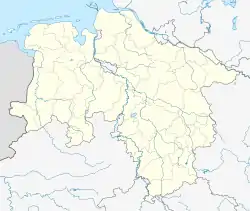Delmenhorst | |
|---|---|
 | |
 Flag  Coat of arms | |
Location of Delmenhorst | |
 Delmenhorst  Delmenhorst | |
| Coordinates: 53°03′02″N 08°37′54″E / 53.05056°N 8.63167°E | |
| Country | Germany |
| State | Lower Saxony |
| District | Urban district |
| Government | |
| • Lord mayor (2021–26) | Petra Gerlach[1] (CDU) |
| Area | |
| • Total | 62.36 km2 (24.08 sq mi) |
| Elevation | 7 m (23 ft) |
| Population (2021-12-31)[2] | |
| • Total | 77,522 |
| • Density | 1,200/km2 (3,200/sq mi) |
| Time zone | UTC+01:00 (CET) |
| • Summer (DST) | UTC+02:00 (CEST) |
| Postal codes | 27747, 27749, 27751, 27753,27755 |
| Dialling codes | 04221 |
| Vehicle registration | DEL |
| Website | www.delmenhorst.de |

Delmenhorst (German pronunciation: [ˈdɛlmənˌhɔʁst] ⓘ; Northern Low Saxon: Demost) is an urban district (Kreisfreie Stadt) in Lower Saxony, Germany. It has a population of 74,500 and is located 10 kilometres (6 miles) west of downtown Bremen with which it forms a contiguous urban area, whereas the city of Oldenburg is 25 kilometres (16 miles) to the northwest. The city has a total area of 62.36 square kilometres (24.08 square miles); and a population density of approx. 1200 inhabitants per km².
History
Delmenhorst was first mentioned in a charter in 1254, after the Count of Oldenburg, Otto I, bought the place near the river Delme in 1234. A castle to protect the newly founded settlement was established in about 1247. The following count, Otto II, made the castle his residency; Delmenhorst was declared an independent town on 15 July 1371 under Bremen's law.
After a short period under the governance of the bishop of Bremen from 1421 to 1436 Delmenhorst returned under the custody of Oldenburg. Delmenhorst later was infamous for its robber-baronship under the count Gerhard VI of Oldenburg. Its reign ended in 1482 thanks to a siege laid to the castle under the leadership of the bishop of Münster. Therefore, the town now was under Münster authority until finally count Anton I won back the town as well as the castle in 1547.
When the last heir of Anton, Christian, died in 1647, Delmenhorst again fell under Oldenburg custody. As Oldenburg belonged to Danish kings and the Oldenburg regent of that time was a relative of the Danish king, Delmenhorst was thereafter under Danish control.
In 1767 Delmenhorst was bought by Tsarina Catherine II, but was given up to new Oldenburg in 1773. In 1777 Delmenhorst was declared a dukedom of Oldenburg. In 1806 a French and Dutch army occupied the territory; Delmenhorst was a part of the French empire under Napoleon from 1811 to 1813.
In the industrial age Delmenhorst experienced great economic growth, thanks to Bremen. Since Bremen was in a different duty zone, merchants who wanted to export manufactured goods outside of Bremen had to pay high customs duties. They therefore only exported the resources and produced their commodities in the surrounding villages. The industries arising were the Jute - a spinning works and weavery in 1871, the Delmenhorster Linoleumfabrik - a linoleum factory, in 1882, the Norddeutsche Wollkämmerei und Kammgarnspinnerei or Nordwolle - another, bigger spinning works, and several others. The number of inhabitants quadrupled in these years.
In 1903 Delmenhorst was declared kreisfrei, meaning it was under its own regentship, not having to obey any other county. In the 1930s Great Depression the Nordwolle went bankrupt - nevertheless the town grew bigger, incorporating several smaller villages around it. On Kristallnacht in November 1938 the synagogue was burnt down by the Nazis, who had come to power in Germany in 1933. After the Second World War, Delmenhorst was in the British zone of occupation and had to deal with thousands of refugees from Eastern Germany, which now was occupied by the Soviet Union. The British-appointed mayor during the British Occupation was Major Jack Wolfe, an inspector of the British Constabulary. In 1950, more than 57,000 people lived in Delmenhorst.
Since the 1960s there has been a steady decrease in employment, leaving more than 13% of the town's inhabitants unemployed and nearly 7% living on social welfare. In the year 2000 Delmenhorst was an outpost of the Hanover-based Expo 2000.
The Hanse-Wissenschaftskolleg (HWK) Institute for Advanced Study is located at Delmenhorst, in the neighborhood of Deichhorst. The HWK promotes collaboration between and among international research scientists and artists, many of whom are housed on the HWK grounds. The public is engaged through a public lecture series. The research areas of focus are energy, earth, brain, and society.[3]
| Largest groups of foreign residents[4] | |
| Nationality | Population (31 December 2018) |
|---|---|
| 2,334 | |
| 1,676 | |
| 1,409 | |
| 1,328 | |
| 1,151 | |
| 973 | |
| 332 | |
| 324 | |
| 261 | |
| 200 | |
Mayors
- Erich Koch-Weser: 1901–1909
- Hermann Hadenfeldt: 1909–1919
- Rudolf Königer: 1919–1933
- Wilhelm Müller: 1933–1937
- Hermann Maas: 1937–1945
- Walter Kleine: 1945–1945
- Johann Schmidt(1870-1949): 1945–1946
- Wilhelm von der Heyde: 1946–1955
- Anton Eickmeier (1912-1955): 1955–1955
- Hans Albers: 1955–1956
- Wilhelm von der Heyde (1885-1972): 1956–1968
- Ernst Eckert (1904-2004): 1968–1974
- Harald Groth (born 1943): 1974–1976
- Otto Jenzok (1928-1984): 1976–1984
- Walter Löwe: 1984–1986
- Erwin Pelka: 1986–1986
- Jürgen Thölke (born 1934): 1986–2001
- Carsten Schwettmann: 2001–2006
- Patrick de La Lanne (born 1962): 2006–2014
- Axel Jahnz: 2014-2021
- Petra Gerlach: since 2021
Main sights
The landmark of the town is the water tower complex with the adjacent town hall, built from 1910 to 1914 by architect Heinz Stoffregen.

Another interesting place is the Burginsel (Castle Island), in which the old castle existed in medieval times. The construction was torn down during the 18th century. Today a park (called the Graft) occupies the grounds of the old castle.
The industrial history of the town is presented by the Nordwolle Museum, an Anchor Point of ERIH, The European Route of Industrial Heritage.[5]
Twin towns – sister cities
Delmenhorst is twinned with:[6]
 Allonnes, France
Allonnes, France Borisoglebsk, Russia
Borisoglebsk, Russia Eberswalde, Germany
Eberswalde, Germany Kolding, Denmark
Kolding, Denmark Lublin, Poland
Lublin, Poland
Notable people

- August Kühnel (1645-ca. 1700), composer and viola da gamba performer (Baroque music)
- Karl Friederichs (1831-1871), classical philologist and archaeologist
- Hermann Rieck (c. 1837-1921), farmer
- Arthur Fitger (1840–1909), painter

- Iwan Bloch (1872–1922), physician and sexologist
- Fritz Stuckenberg (1881–1944), painter
- Reinhard Kuretzky (born 1947), athlete, pole vaulter
- Wolfgang Michels (1951–2017), musician, singer, composer and author
- Volker Wieker (born 1954), General Inspector of the Bundeswehr
- Gerd U. Auffarth (born 1964), Professor of Ophthalmology, Heidelberg University
- Claudia Kemfert (born 1968), environmental economist and energy expert
- Tim Fischer (born 1973), composer
- Ernst-Marcus Thomas (born 1973), television presenter
- Christian Dürr (born 1977), politician (FDP)
Associated with the city
- Gerhard VI, Count of Oldenburg (1430–1500), ruler of the castle of Delmenhorst
- Henrich Focke (1890–1979), co-founder of the company Focke-Achgelis in Hoykenkamp (Ganderkesee)
- Walter Többens (1909–1954), textile entrepreneur with production and trading
- Hans-Joachim Hespos (1938–2022), composer, founded the concert series 11.11 new music in Delmenhorst
- Sarah Connor (born 1980), singer and since 2003 "honorary messenger" of the city
References
- ↑ "Stichwahlen zu Direktwahlen in Niedersachsen vom 26. September 2021" (PDF). Landesamt für Statistik Niedersachsen. 13 October 2021.
- ↑ "LSN-Online Regionaldatenbank, Tabelle A100001G: Fortschreibung des Bevölkerungsstandes, Stand 31. Dezember 2021" (in German). Landesamt für Statistik Niedersachsen.
- ↑ "HWK". Hanse-Wissenschaftskolleg. Archived from the original on 2015-09-27. Retrieved 2017-02-01.
- ↑ "Ausländische Bevölkerung nach Nationalität" (PDF). Stadt Delmenhorst. Archived from the original (PDF) on 2014-10-16. Retrieved 2014-10-13.
- ↑ "ERIH- Nordwolle". European Route of Industrial Heritage. 2014. Archived from the original on 22 September 2014. Retrieved 17 January 2015.
- ↑ "Partnerstädte". delmenhorst.de (in German). Delmenhorst. Retrieved 2021-02-11.
External links
- (in German) Delmenhorst Homepage
- (in German) webcam providing a view over the market place from the top of the town hall Archived 2018-03-15 at the Wayback Machine
- (in German) Search in the Delmenhorster Bibliography (the total bibliography as PDF (461 kB))
- (in German) Delmenhorst News
- (in German) Delmenhorst heritage association